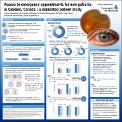Access to emergency eye care appointments in Quebec, Canada : a simulated patient study
| dc.contributor.author | Tousignant, Benoît | |
| dc.contributor.author | Binette, Catherine | |
| dc.contributor.author | Duchesne, Ariane | |
| dc.date.accessioned | 2024-04-29T12:02:20Z | |
| dc.date.available | NO_RESTRICTION | fr |
| dc.date.available | 2024-04-29T12:02:20Z | |
| dc.date.issued | 2023-10-12 | |
| dc.identifier.uri | http://hdl.handle.net/1866/32992 | |
| dc.title | Access to emergency eye care appointments in Quebec, Canada : a simulated patient study | fr |
| dc.type | Contribution à un congrès / Conference object | fr |
| dc.contributor.affiliation | Université de Montréal. École d'optométrie | fr |
| dcterms.abstract | Purpose Optometrists play an important role in primary eye care, including providing ocular emergency consultations. This study aims to describe the accessibility of ocular emergency appointments for new patients in optometry practices throughout Quebec, Canada. Methods This cross-sectional study assesses the possibility to obtain an appointment, along with associated delays and costs in optometric practices in Quebec, Canada. Simulated patients calls, taking the role of a new patient seeking an emergency appointment, were made in 89 clinics across the province, divided between urban, semi-urban and rural areas. Each clinic received one call for a low morbidity emergency (acute red eye), and one call for a high morbidity emergency (recent onset of flashes). Descriptive statistics were performed, along with intra- and inter-group comparisons using parametric (χ2) or non-parametric tests (Fisher’s exact test, Wilcoxon signed-rank test, Kruskal-Wallis H test). Results The proportion of the clinics that granted at least one eye emergency appointment was 46.1%, with differences according to areas: 40% in urban areas, 30% in semi-urban areas and 68.9% in rural areas (X2 [2, N = 89] = 9.7, p = 0.008). The median delay was 3.72h (IQR = 4.6) and the median price for an ocular emergency appointment was 55 CAD$ (IQR 15.0). Obtaining at least one type of appointment was more probable in rural areas compared to urban areas (X2 [1, N = 60] = 3.28, p = 0.004), or to semi-urban area (X2 [1, N = 60] = 6.67, p = 0.001). However, patient scenarios with high morbidity conditions did not yield better chances of obtaining an appointment than those with a low morbidity condition (X2 [1, N = 178] = 0.23 p = 0.63). There were no differences between areas for median delays (Kruskal-Wallis, H(2) 2,2 = p < 0,3), nor for median prices of an ocular emergency appointment (Kruskal-Wallis, H(2) 3,535, p = 0,17). Conclusion The proportion of optometry clinics offering emergency appointments to new patients in Quebec is uneven, ranging from 30% to 68.9%, favoring rural practices. Median delays and median prices of an ocular emergency appointment seem uniform across the province regardless of morbidity. These data can be useful in planning and advocacy efforts to improve accessibility to emergency eye care services in Quebec. | fr |
| dcterms.language | eng | fr |
| oaire.citationTitle | American Academy of Optometry | fr |
| oaire.citationConferencePlace | New Orleans (USA) | fr |
| oaire.citationConferenceDate | 2023-10-12 | fr |
Files in this item
This item appears in the following Collection(s)
This document disseminated on Papyrus is the exclusive property of the copyright holders and is protected by the Copyright Act (R.S.C. 1985, c. C-42). It may be used for fair dealing and non-commercial purposes, for private study or research, criticism and review as provided by law. For any other use, written authorization from the copyright holders is required.


